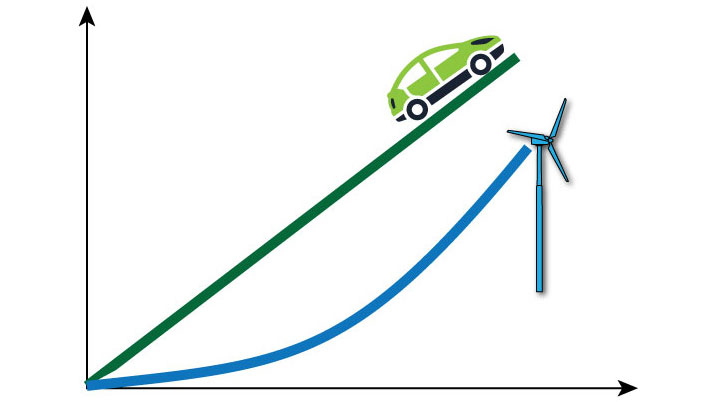Currently, road transport contribution to global CO2 emissions is around 23%. The main options to reducing the CO2 emissions from the transport sector are electric cars and fuel cell cars powered by hydrogen.
Hydrogen vs. electric cars?
Norway has had a tremendous increase in electric cars on the roads over the past few years, and now the interest in fuel-cell cars is also increasing. We will not venture to predict what type of cars will be the winner in the long run in Norway or internationally – or whether we will have transport systems where both types have their roles. However, in order to significantly reduce the CO2 emissions from the transport sector, the use of these types of cars should increase substantially.

We will not venture to predict what type of cars will be the winner in the long run in Norway or internationally
A substantial increase in the use of electric cars on a global scale will require a considerable increase in electric power generation capacity, whereas a substantial increase in fuel cell-driven cars will require a considerable increase in hydrogen production capacity.
More energy only from renewable sources?
Ideally, in the long term, all the required power generation and/or hydrogen production for cars should come from renewable sources.
However, a rapid increase in the use of non-CO2-emitting cars could be necessary to meet CO2 emission reduction targets, an increase that is more rapid than what the increase in renewable energy can match. Also, fossil fuels are available, abundant and not unlikely to be employed both for electric power and for hydrogen production in many years to come.
- Do you want to know more about the international energy market? You can find statistics on the International Energy Agency website.
Hydrogen production relies on fossil fuel
Globally, current hydrogen production relies to more than 90% on fossil fuels. Consequently, for the transport sector to reduce its contribution to global warming, this use of fossil fuels would have to be combined with CCS (CO2 capture and storage).
Hydrogen production, liquefaction and transport by ship to Japan was described earlier by David Berstad and Petter Nekså in Norwegian business daily “Dagens Nærlingsliv” and on gemini.no. This study found that the hydrogen rate relevant for export to Japan (225 kilo-tonnes per year as base case) cannot realistically be produced and liquefied based on renewable energy sources, as this would require 10–12 % of the current Norwegian electricity generation capacity as well as tremendous extension of power transmission capacity to the location of production. The most realistic solution would be to base hydrogen production on natural gas reforming with CCS, which would consume only roughly 1.5 % of the gas production volume. A gradual phasing-in of renewable energy should be considered if this capacity increases sufficiently.
An option: Norwegian natural gas with CCS to produce hydrogen
Hydrogen can be produced from electrolysers using electricity as well as from natural gas, in combination with CO2 capture (CCS). Electrolysers have the advantage of being able to respond quickly to load changes from wind or solar power.
Hydrogen-production from natural gas, on the other side, is a process with slow load response – but natural gas is available in large quantities in Norway: The energy contents of the gas exported from Norway annually is about ten times that of the annual Norwegian hydropower production.
Hydrogen for cars from coal with CCS?
From a global perspective, coal is a more abundant energy source than natural gas, and hydrogen production from coal, in combination with CCS, could also play a role when reducing the contribution to global warming from the transport sector. SINTEF researchers recently presented a concept for coal-based hydrogen production and liquefaction that shows how a self-sustained process with CO2 capture could be designed (in addition to hydrogen, the process generates the power required for CO2 capture and H2 liquefaction). The concept is just as applicable for hydrogen production from natural gas.
The energy contents of the gas exported from Norway annually is about ten times that of the annual Norwegian hydropower production.
In short, a possible solution for hydrogen production for cars could be to use fossil fuels (natural gas or coal) with CCS for “base-load” hydrogen production, and gradually combine this with the use of electrolysers at times when electricity prices are low, due to abundant wind and solar power on the market. It remains to be determined through further research how the electrolysers and fossil fuel reforming can be combined in in practice in the best possible way to generate close to emission free hydrogen for fuel cell vehicles. In such studies, also the role of electric cars could have a role.
Why is this important?
The use of fossil fuels for power generation, transport and in industry has led to increased CO2 concentration in the atmosphere. The concentration is ~400ppm today, compared to a typical pre-industrial value of 280 ppm, and with “business as usual” utilisation of fossil fuels, the concentration could reach levels around 600 ppm at the end of this century. The increase in CO2 concentration means that the long-wave heat radiation emitted from the earth is to an increasing extent re-reflected back to earth, and heating the atmosphere (global warming).
For large point-sources of CO2 (fossil fuel power plants and many industries), CO2 Capture and Storage (CCS) is one option to reduce CO2 emissions from fossil fuels. (Biofuels, solar power, wind power and energy efficiency measures are other options.) Capturing CO2 from the exhaust gas of cars and trucks is however not possible from any practical or economic viewpoint.











Comments
No comments yet. Be the first to comment!